“If we look the way we do”, we have to look at genetics that provides us with an understanding of inheritance, which can provide us with knowledge about how we inherit characteristics from our parents and ancestors. Through the study of heredity we can understand the importance of variation in any living thing in a dynamic environment.
First, we need to refer to the cell structure then, to observe how important the process of Meiosis is for the formation of sex cells, and to explain the function of heredity. Finally, we will discuss about the probability of heredity and its different components.
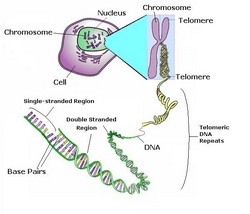
We are made of cells, which are the basic unit of structure and function in all living things. Within the cell, a seemingly mysterious substance found in the nucleus is DNA, known as the genetic material. In the cell, the DNA or genetic material gives information and all the instructions to make a new cell. Most of the time, the genetic material takes the form of long, very thin threads, which are difficult to see. But when the cell divides to make new cells, the long threads coil up and shorten to form chromosomes which are easy to see under the microscope. By unraveling the chromosomes we will find two strands of DNA coiled around each other, which form a structure called a double helix. This structure looks like a spiral ladder and each rung of the ladder consists of a pair of chemical groups called bases. These bases are: Adenine, Thymine, Cytosine, and Guanine, and are used in repeating patterns of A’s, T’s, C’s, and G’s. The order of these bases are always different and several thousands of them are found in a gene, a segment or section of DNA. The arrangements of these chemicals made scientists suspect that patterns were like a code that send instructions to the cell. Therefore, they called it the genetic code with each gene as a recipe for different kinds of proteins. For an example, lets suppose that the gene with the genetic code: AATCCCCGGTAAAAAATGGATCTTA is for brown eyes. The genetic material in the nucleus would send the order with the above genetic code to the ribosomes, a particle consisting of RNA with a role to produce proteins. The ribosomes would make the protein for brown eyes and the protein would be transported to the eye cell of the baby in formation. Then, the baby would have brown eyes.
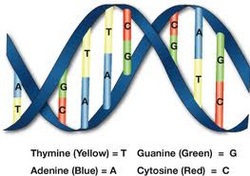
Lets note that if there is a mistake in one gene of a chromosome. Instead of the base A, for example, the DNA molecule might have the base G. Such a mistake is one type of mutation that can occur in a cell’s hereditary material and may be helpful, neutral, or harmful, depending on how it affects the organism’s ability to survive in its environment. Recall that a mutation is any change in a gene or chromosome, mutations can cause a cell to produce an incorrect protein during protein synthesis. As a result, the organism’s trait, or phenotype, may be different from what it normally would have been.
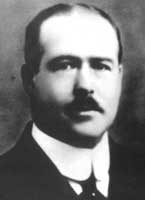
Then, according to the chromosome theory of inheritance founded by Walter Sutton, organisms produce sex cells during meiosis. Meiosis is the process by which the number of chromosomes is reduced by half to form sex cells— sperm and eggs. During meiosis, the chromosome pairs separate and are distributed to two different cells. The resulting sex cells have only half as many chromosomes as the other cells in the organism. When they combine, each sex cell contributes half the number of chromosomes to produce offspring with the correct number of chromosomes.
In Sutton’s discovery with grasshoppers, he noticed that each body cell had 24 chromosomes arranged in 12 pairs. However, each sex cell- sperm and egg cell, contained only 12 chromosomes, half the number found in body cells. When a male sex cell joined with a female sex cell, the resulting fertilized egg had 24 chromosomes arranged in 12 pairs, exactly the same as its parents. Sutton concluded that chromosomes carried genes from one generation to the next.
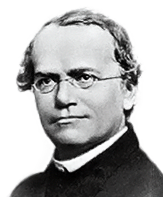
To inherit either the color of your mom’s eyes or the nose shape of your dad, those characteristics are found in the genes, in the chromosomes in the nucleus of the cell. Inheritance is the transmission, or passing on, of characteristics controlled by genes from both parents to their children. In the experiments of Gregor Mendel who was curious about the different forms of characteristics, or traits, of pea plants. He crossed two pea plants that differed in height and crossed purebred tall plants with purebred short plants. These parent plants, the P generation, were purebred because they always produced offspring with the same trait as the parent. In all of Mendel’s crosses, only one form of the trait appeared in the F1 generation. However, in the F2 generation, the “lost” form of the trait always reappeared in about one fourth of the plants. From his results, Mendel reasoned that individual factors, one from each parent, control the inheritance of traits. Today, scientists call the factors that control traits, genes and the different forms of a gene are called alleles.
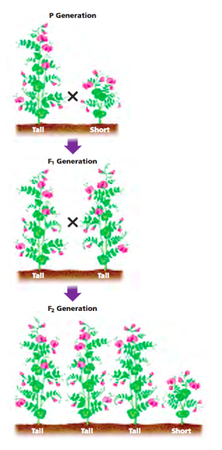
An organism’s traits are controlled by the alleles it inherits from its parents. Some alleles are dominant, while other alleles are recessive. A dominant allele is one whose trait always shows up in the organism when the allele is present. A recessive allele is hidden whenever the dominant allele is present. A trait controlled by a recessive allele will only show up if the organism does not have the dominant allele present. This explains what happened in Mendel’s cross. The purebred tall plant had two alleles for tall stems. The purebred short plant has two alleles for short stems. The F1 plants are all hybrids: they have two different alleles for the trait—one allele for tall stems and one for short stems. Geneticists use a capital letter to represent a dominant allele and a lowercase version of the same letter for the recessive allele. Because of his work, Mendel is often called the Father of Genetics.
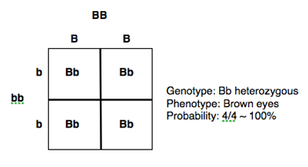
Finally, we need to define the genotype (genetic makeup, or allele combinations) and phenotype (physical appearance, or visible traits) from Punnett Squares, a chart which shows or predicts all possible gene combinations in a cross of parents (whose genes are known). In Punnett Squares, the use of capital letters (B) represent the dominant gene and the lower case letters (b) represents the recessive gene. If an organism has two dominant genes (BB) or two recessive genes (bb) they are called homozygous, meaning that they have identical alleles for a trait. An organism with one dominant and one recessive gene (Bb) is called heterozygous, meaning that they have two different alleles for a trait.
For an example: if your dad has two dominant brown genes (BB) and your mom has two recessive blue genes (bb), by using the Punnett Square you can find the probability of what the offspring’s eye color could be. (Looking at the figure below, shows the results of this cross.) As you can see, all the offspring’s genotype are heterozygous (Bb) and the phenotype of each offspring would be brown eyes because the dominant allele is present.
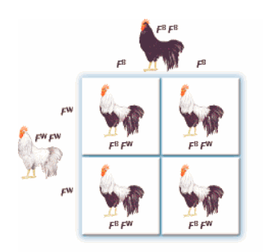
In some cases, an organisms alleles are neither dominant nor recessive, this is called codominance. As a result, both alleles are expressed in the offspring.
For example: heterozygous chickens have both black and white feathers. The alleles for feather color are codominant, neither dominant nor recessive. As you can see in the figure below, neither allele is masked in the heterozygous chickens. Notice also that the codominant alleles are written as capital letters with superscripts--FB for black feathers and FW for white feathers. As the Punnett square shows, heterozygous chickens have the FBFW allele combination.

Punnett Squares also provide the probability percentage of an offspring. Referring back to the first example above, all the offsprings were heterozygous (Bb) means that 4/4 or 100% of the offsprings were with the dominant gene, brown eyes and for the second example, all the offsprings were heterozygous (FBFW) this also means that 4/4 or 100% of the chicken offsprings were with black and white feathers.
All these concepts above help to explain the results of genetic crosses, their probability and heredity.
By studying genetics, the genes, heredity and variation in living organisms we had tried to understand the process of inheritance. Just as a long and winding road that led to the explanation of “why we look the way we do?”, all these “stuff” that makes us is incredible and are the secret process of life.








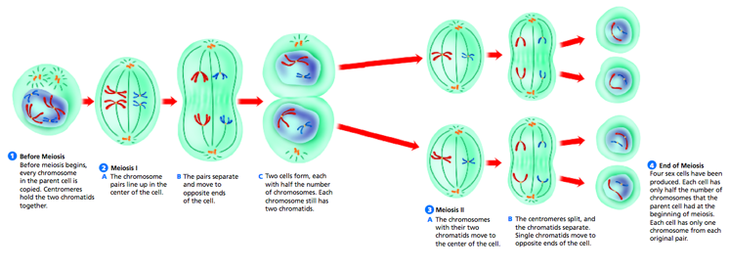
 RSS Feed
RSS Feed